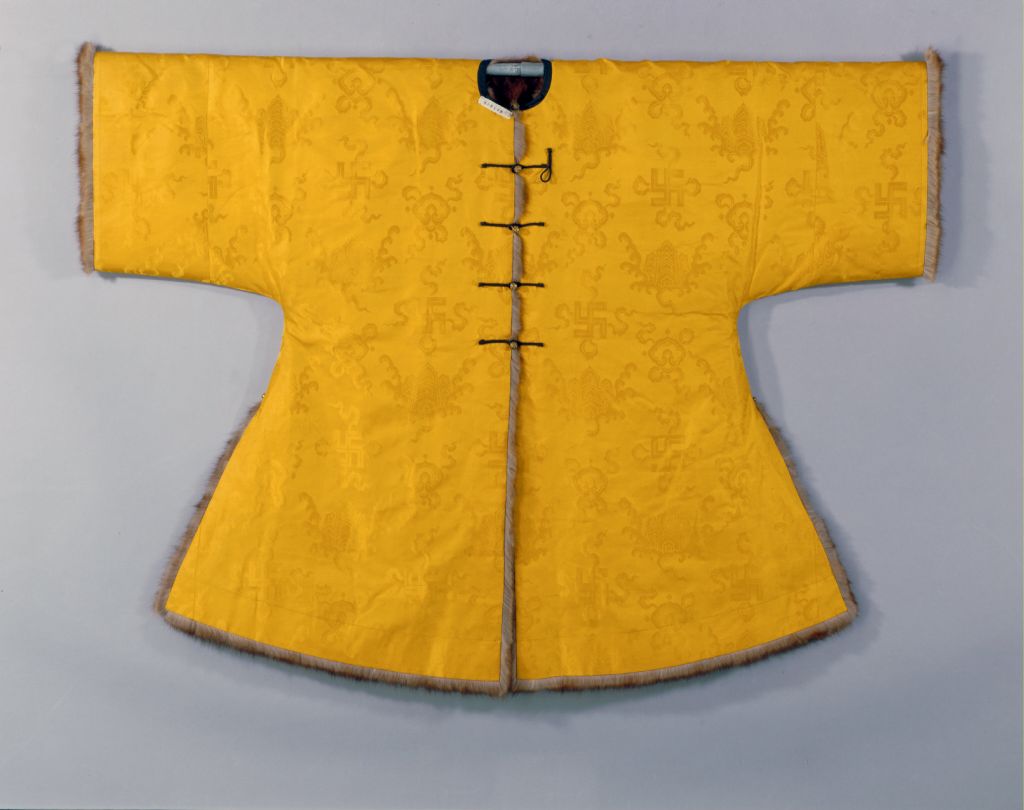[Zhao Ji’s Lotus and Golden Rooster Painting Axis]
The Lotus and Golden Rooster Painting Axis, (biography) painted by Zhao Ji, the Emperor of Huizhou in the Northern Song Dynasty, is printed in silk and colored. 81.5 cm vertically and 53.6 cm horizontally
As an independent branch of painting, the flower-and-bird painting of the Song Dynasty has reached a high artistic level in both the drawing skills and the form of expression, and the “Lotus and Golden Rooster” is one of the best works. This picture is a flower and bird painting depicting the golden autumn scenery. In the picture, the hibiscus is in full bloom, fluttering gently with the wind, butterflies fluttering, chasing and playing with each other, causing the golden pheasant on the branch to look back and stare. On the upper right of this picture, Zhao Ji, the Emperor of the Song Dynasty, inscribed in thin gold body, “The autumn strength rejects the frost, and the crowned golden pheasant. It is known that all five virtues, and the ease wins over the fu”. On the lower right, the book reads “The Emperor of the Xuanhe Hall and the Book”, and the cursive inscription “One person in the world”. The chicken has always been known as “virtuous bird” in China. “The chicken has five virtues: the one who wears the crown, the one who is also literate; the one who has enough fight distance, the one who is brave; the one who is brave when the enemy is in front, the one who is benevolent; the one who keeps watch at night, the one who believes” is recorded in the “Han Shi Wai Zhuan”. It can be seen that its character of being both civil and military, benevolent and brave, and faithful and single-minded is appreciated by the world. It is no wonder that a generation of emperors with unparalleled talent and skills will also leave the poem “knowing all the five virtues, being comfortable and winning over the Fu”, It shows the praise for the character of ease and nobility, which reflects the humanistic implication of Chinese flower and bird painting
In the works entitled Zhao Ji, which are currently circulated around the world, the artistic style shows two different aspects: exquisite and simple, which are quite different from each other. Exquisite and exquisite, such as “The Painting of Hibiscus and Golden Rooster”, “The Painting of Birds in Lamei Mountain” (collected by the Taipei Palace Museum), and simple and simple, such as “The Painting of Willows and Crows” (collected by the Shanghai Museum), “The Painting of Birds in Loquat Mountain”, and so on. Through the comparative analysis of pen and ink styles, Mr. Xu Bangda pointed out that the former was not the work of Zhao Ji, but the work of painters in the painting academy, and the latter was his own handwriting, which was recognized by most art history researchers. In addition, the existing volume III of the Collection of Southern Song Pavilion, which records the paintings collected by the court of the Southern Song Dynasty, includes this painting in the category of “imperial paintings” alongside “imperial paintings”, indicating that “The Painting of Lotus and Golden Rooster” is only a flower and bird painting inscribed by Zhao Ji, not his own painting. Therefore, despite the inscription of Zhao Ji on the picture, the author of the picture is a master of the painting academy without leaving his name
As the emperor who paid the most attention to art and painting in Chinese history, Zhao Ji, Emperor Huizong of the Song Dynasty, collected a wide range of famous paintings and monuments during his reign, compiled the calligraphy and painting catalogues of the royal painting collection – “Xuanhe Shupu” and “Xuanhe Shupu”, established the Imperial Painting Academy and improved its system, and personally guided the study and creation of painters in the Academy according to his own aesthetic concepts. With regard to painting creation, Zhao Ji, while paying attention to the meticulous representation of the object being painted, also requires that the picture contain the artistic conception of poetry, which makes people have a memorable artistic experience. “The Painting of Lotus and Golden Rooster” undoubtedly perfectly reflects the aesthetic thought of the highly artistic emperor. The fine lines of the double hook method used in the whole picture are not only accurate in the shape of the flowers and leaves and the golden pheasant, but also the drooping and swaying state of the hibiscus pressed by the golden pheasant can be faithfully reflected. In addition, the color halo is dyed in a clear layer, and the color is appropriate. The magnificence contains a dignified and elegant temperament, which can be called “both the form and the spirit, and the melody is perfect”. As far as the composition is concerned, the lotus and golden pheasant are concentrated on the left side of the painting, echoing with the light flying butterflies on the upper right, making the intricate layout appear dense and sparse, giving way to each other. The poems written in lean and vigorous style and the exquisite and beautiful pictures are even more complementary.
![图片[1]-Axis of Zhao Ji’s Lotus and Golden Rooster-China Archive](https://chinaarchive.net/Northern Song dynasty/painting/27589[1024].jpg)
![[Qing Dynasty] British female painter—Elizabeth Keith, using woodblock prints to record China from the late Qing Dynasty to the early Republic of China—1915-China Archive](https://chinaarchive.net/wp-content/uploads/2022/11/image-191x300.png)




